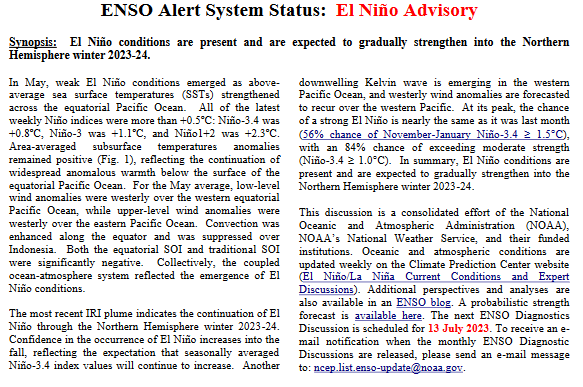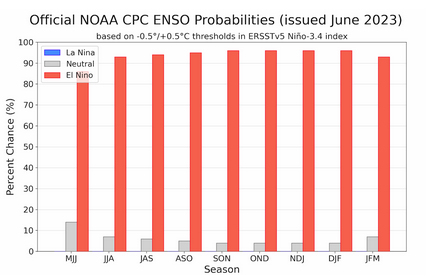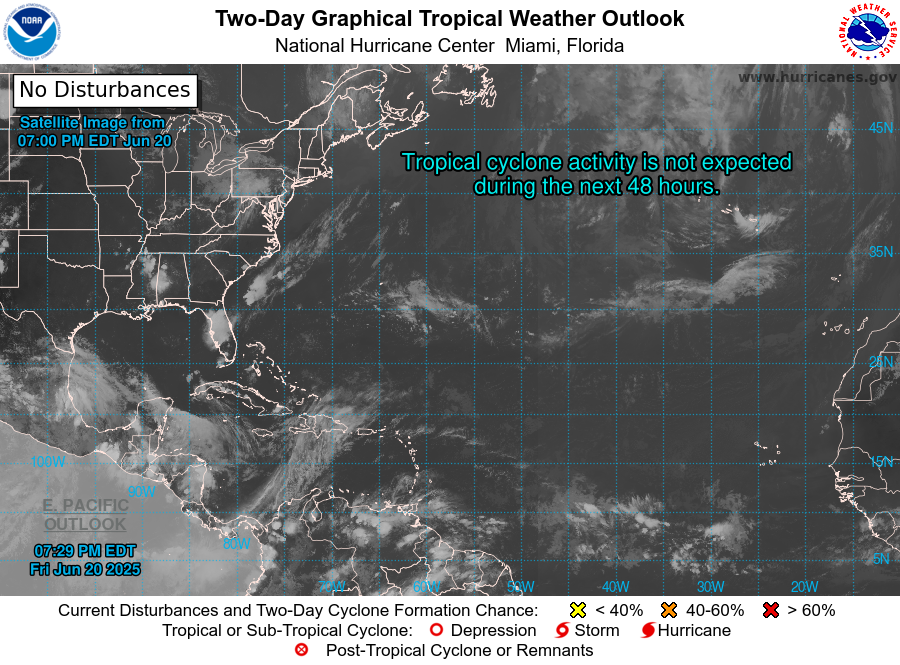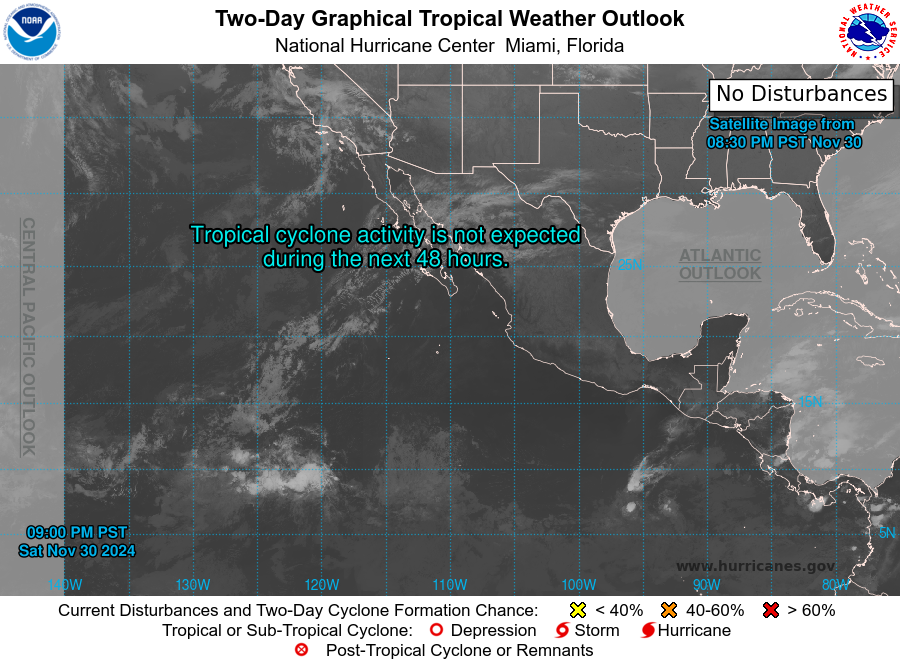Here is what we are paying attention to in the next 48 to 72 hours. The article also includes weather maps for longer-term outlooks and a five-day World weather forecast.
We start with the U.S. Information.
Short Range Forecast Discussion
NWS Weather Prediction Center College Park MD
Sat Jun 17 2023Valid 12Z Sat Jun 17 2023 – 12Z Mon Jun 19 2023
…Very rainy and stormy across the Southern Plains, Middle/Lower
Mississippi Valley and Southeast……Record setting heat possible from southern Texas to eastern Louisiana;
Critical Fire Weather likely over portions of the Southern Plains and
Southwest……Smoke from Canadian wildfires to continue impacting the Upper
Mississippi Valley, Great Lakes, Midwest, Northeast and Mid-Atlantic…

| Information Note: This article is now set up so that all the maps should automatically update. The links are provided but should not be needed. The downside is that if you go back to a previous version the maps will have been updated and not be relevant to the date of the prior article but will be current information. The NWS twice-a-day 48-hour forecasts do not auto-update in this article. I do it and I can be late doing it. The link for the NWS updates is HERE. Most of our other articles will not be set up to auto-update so that prior versions of the article will be meaningful.
Tonight we published the NOAA Four Season Outlook To read it, click HERE. Remember the easiest way to get back to the article you were reading is to hit the return arrow in the upper left of your screen. There are other ways. |
We start with the ENSO Alert System Update. We were asleep last week and got confused with May. The ENSO Alert status is updated on the second Thursday which was the 8th of this month the earliest in the month it can be. We will provide the full report later but for now the two key slides.

| The key here is the statement “At its peak, the chance of a strong El Niño is nearly the same as it was last month (56% chance of November-January Niño-3.4 ≥ 1.5°C), with an 84% chance of exceeding moderate strength (Niño-3.4 ≥ 1.0°C)”. Get ready. |

| At this point, the real question is about the Spring of next year. |
Back to current weather, first, the 48-Hour Forecast (It is a 48 to 72 Hour Forecast actually)
Daily weather maps. The Day 1 map updates twice a day and the Day 2 and 3 maps update only once a day. These maps update automatically. But if that does not happen, you can get updates by clicking HERE
TODAY (or late in the day the evening/overnight map will appear)
TOMORROW
NEXT DAY
This animation shows how things may play out over the next 60 hours. To update click here.
The NWS Climate Prediction Center’s: Watches, Warnings, and Advisories plus other information can be found HERE.
ATMOSPHERIC RIVERS
This tells us what is approaching the West Coast. Click HERE to update If I have not gotten around to doing the update. Here is some useful information about Atmospheric Rivers.
Continuation of the NWS Short Range Forecast. It is updated by NWS twice a day and these updates can be found here. We post at least one of those updates daily, sometimes both. The Highlights are shown in the lede paragraph of this article.
Troughing over the Central/Southern Plains will move into the Lower
Mississippi Valley and Southeast this weekend. Quasi-stationary fronts
will be the focus for scattered showers and thunderstorms as well as
potential excessive rainfall and severe weather. An Enhanced Risk of
Severe Thunderstorms is in effect over parts of southern Kansas, Oklahoma
and the Texas panhandle this afternoon, where damaging wind gusts of over
70 knots and hailstones greater than 2 inches in diameter are possible.
This severe weather threat could reach the ArkLaTex after midnight as well
as parts of the central Gulf Coast and Florida where a broad Slight Risk
is in effect. There are flash flooding concerns over portions of Florida’s
central Gulf coast, including Tampa Bay and points north, today as
substantial Gulf moisture is expected to interact with a stationary front
draped across the region. Between 2-4 inches of rain are possible for this
area, which supports a Slight Risk of Excessive Rainfall.The severe weather and excessive rainfall threats shift into the
Middle/Lower Mississippi Valley on Sunday as surface low pressure shifts
into the region. Scattered shower and thunderstorm activity are expected
to continue around the aforementioned areas while the heaviest rainfall
and severe thunderstorms are likely to form around the surface front
draped across the region. Another Enhanced Risk of Severe Thunderstorms is
in effect for much of Arkansas, Mississippi, northern Louisiana and
southwestern Alabama on Sunday with damaging gusts being the primary
sensible weather threat from these storms. Isolated large to very large
hail are also possible. 1-3 inches of rainfall over portions of
southeastern Missouri, eastern Arkansas, western Tennessee, Mississippi
and Alabama supports a Slight Risk of Excessive Rainfall leading to Flash
Flooding for those areas on Sunday.Anomalously warm temperatures are expected to continue across southern
Texas and parts of the central Gulf Coast for the next several days as an
upper-level ridge centered over northern Mexico continues to pump warm air
into the region and keep skies relatively clear. High temperatures in the
100s and lows in the upper 70s to low 80s from southern Texas to the
Louisiana coast will likely tie or break records, at least through early
next week. Warm, dry and windy conditions will support Critical Fire risk
today before conditions become less favorable for fires on Sunday. Some
Canadian wildfire smoke will continue to circulate across parts of the
Midwest, Great Lakes, Northeast, Mid-Atlantic and Southeast over the next
couple of days.
Learn about wave patterns HERE.
Below is the current five-day cumulative forecast of precipitation (Updates can be found HERE)
Now we look at Intermediate-Term “Outlook” maps for three time periods. Days 6 – 10, Days 8 – 14, and Weeks 3 and 4. An outlook differs from a forecast based on how NOAA uses these terms in that an “outlook” presents information as deviation from normal and the likelihood of these deviations.
Below are the links to obtain updates and additional information. They are particularly useful if you happen to be reading this article significantly later than when it was published. I always try to provide readers with the source of the information in my articles.
| Days 6 – 10 (shown in Row 1) | Days 8 – 14 (Shown in Row 2) | Weeks 3 and 4 (Shown in Row 3 but updates only on Fridays) |
| https://www.cpc.ncep.noaa. gov/products/predictions/610day/ | https://www.cpc.ncep .noaa.gov/products/predictions/814day/ | https://www.cpc.ncep.noaa.gov/products/predictions/WK34/ |
Showing the actual maps. They should now update automatically. The Week 3 – 4 Outlook only updates on Fridays. So below is what I call the Intermediate-term outlook. On Fridays, it extends out 28 Days. That declines day by day so on Thursday it only looks out 22 days until the next day when the Week 3 – 4 Outlook is updated and this extends the outlook by one additional week.
| 6
– 10
|
|
|
| 8
– 14 |
|
|
| 3
– 4 |
|
|
HAZARDS OUTLOOKS
Click here for the latest complete Day 3 -7 Hazards forecast which updates only on weekdays. Once a week probably Monday or Tuesday I will update the images. I provided the link for readers to get daily updates on weekdays. Use your own judgment to decide if you need to update these images. I update almost all the images Friday Night for the weekend edition of this Weather Report. So normally readers do not need to update these images but if the weather is changing quickly you may want to.
Temperature month to date can be found at https://hprcc.unl.edu/products/maps/acis/MonthTDeptUS.png
Precipitation month to date can be found at https://hprcc.unl.edu/products/maps/acis /MonthPNormUS.png
World Forecast
Below are the Day 1 -3 and 4-6 forecasts for temperature and precipitation. Updates and much additional information can be obtained HERE
World Temperature Anomalies
World Accumulated Precipitation
This information is provided by the University of Maine. They draw upon many different sources. There is a lot of information available at the link provided. I have just provided two useful forecasts. There are probably over a hundred different forecasts available from this source.
Worldwide Tropical Forecast (This is a NOAA Product)
This graphic updates on Tuesdays) If it has not been updated, you can get the update by clicking here Readers will only have to do that if they are reading this article much later than the date of it being published.
–
Information on Tropical Storms can be found HERE. Western Pacific information can be found HERE.


–
| I hope you found this article interesting and useful. |
–
